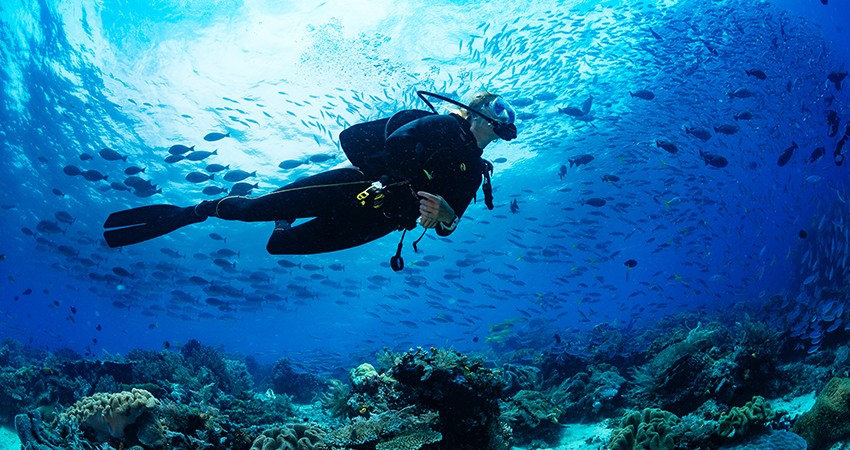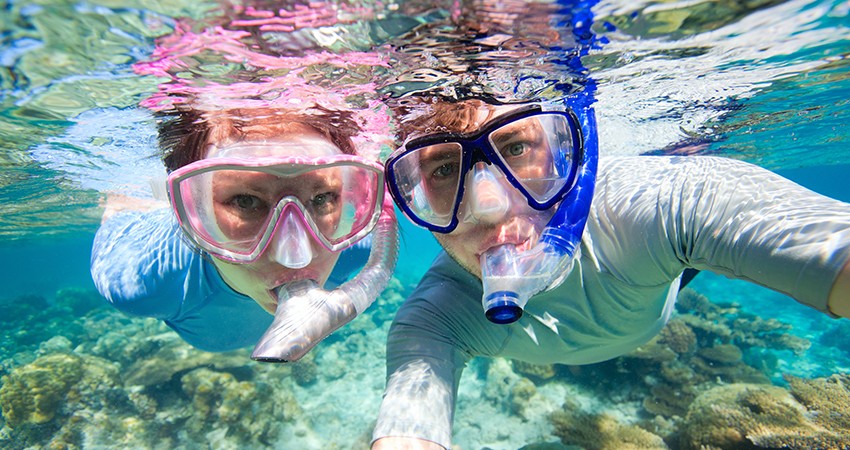Diving Sites in Port Blair







When you dive from the shore rather than from a boat, it is called shore diving. There are a number of fantastic dive sites just off the shores. That’s why you don’t have to take a boat when you have some incredible diving opportunities right on your doorstep. This kind of diving can be quite strenuous and challenging at times. However, it is perfect for swimmers as well as non-swimmers.
Dive Andaman, a 5-star PADI centre, is there with you at every step when you have finally decided to take the leap of faith. If you are a non-swimmer, even then you should consider doing shore diving. Of course, you may think that “I will be in the water, surrounded by water, and I can’t swim. Is that a good idea for me?”. In one word, the answer is ‘Yes’. If you want to dive, then go dive. Nothing should stop you ever from exploring the rich marine life of the Andaman Islands.
There are a number of benefits of shore diving, especially if you suffer from seasickness. In comparison with boat diving, shore diving is a lot more flexible. There are a number of shore dive locations that offer great night diving opportunities as well. You will just require a decent dive light to see properly. For those interested in shore diving, there are so many excellent diving sites available worldwide.
Advantages of Shore Diving
Shore diving is quite popular in Havelock Island (now known as Swaraj Dweep officially). Some of the many benefits of this kind of scuba diving are presented below:
- You can simply walk in right off the beach as you don’t require a boat to reach the dive site.
- Scuba diving in the Andamans is easily accessible. There are many shore diving sites along the coast that offer a great experience, especially to first-timers.
- Shore diving is perfect for all levels of divers, ranging from recently certified Open Water Divers to expert diving professionals.
- There is a lot to see! Just walk straight in from the beach and spot incredible aquatic life including colourful fishes and corals. Simple, right?
- Shore diving is affordable as you don’t have to pay expenses for a boat. All you need is scuba gear. And if you have your own gear, then it’s even cheaper. You will have to pay for air-fill only.
- Shore diving is a relaxed way of diving as there is no rush to stick to a schedule. Thus, you can spend your time talking to your diving buddies as you get ready and also after the dive. These diving buddies can become your good friends as well and you can go for your scuba diving adventures with them in the future.
- One can go shore diving in the Andaman Islands in nearly any weather condition. It has a number of sites that are perfect for shore dives.
- If you are someone who suffers from seasickness, then you don’t have to worry about that since there is no such problem while shore diving.
Exploring the underwater world via shore diving is really fun. It is safe as well as rewarding. If you are also willing to try your hand at this when holidaying in Havelock Island, then contact Dive Andaman, a 5-star PADI centre on the island. The equipment will be provided here and you can enjoy scuba diving with an experienced instructor who will be there with you at all times.
Who says that you always need a boat to scuba dive? You can dive on the shore as well. It is called shore diving and it is very much rewarding as well. This is something that you should definitely try when vacationing in the Andaman and Nicobar Islands since this destination is home to the marvellous underwater world.
What is Shore Diving?
As evident from the name, shore diving means to dive from the shore rather than from a boat. Getting a boat to scuba dive is not possible and economical all the time. Moreover, there are various advantages of shore diving that we are explaining in this article.
Tips for Shore Diving
As rewarding as it can be, shore diving is not always easy. We present here a few important things that you should keep in mind in order to make your shore diving easy and smooth. These simple shore diving tips can make your entire experience a bit easier.
Plan Your Entry and Exit Well in Advance
This is not a major issue as such, but it is specifically relevant on rocky shores in tidal regions. Have a contingency plan before committing and make sure of your exit.
Plan ahead to keep Work Level Low
Simply getting to the entry point with all your scuba gear is pretty tiring when it comes to shore diving. When you are doing that, make sure that you are in sync with your buddy so there’s no hanging around. Sometimes, you can find that it is easier to set up the scuba unit and bring it and your weight belt to the entry point before suiting up. Always make sure that you are nice and relaxed before getting under the water. So take your time accordingly.
Putting on and Taking off your Fins
When conditions are favourable, wading out to waist-deep water is ideal. You can use your buddy’s shoulder for support as you slip your fins on.
Finding your Way Back
Line up a couple of obvious landmarks on your way out to find your way back easily.
Getting Out of the Water
It is fun to stay at the bottom on a gradually sloping shoreline until you are in water less than a meter deep. You can take off your fins there. If there are boats and other water users, then swim on the surface. Your instructor will help you get to your feet. You should stay down, keep your fins on, and crawl out of the water in case there’s any doubt about getting up. It will work pretty well.
During a shore dive, you enter the water from the land rather than a boat. Havelock Island is a great destination for this type of diving and you can explore incredible marine life here at a relaxing pace that suits your travel plan. The conditions are usually calm when you go shore diving. That’s why it is a popular choice for PADI courses, snorkelers, and new divers. Sore diving is a lot to offer and sometimes, it easily rivals offshore sites. There are world-class shipwrecks that you can explore via shore diving at some places. Moreover, you can also encounter creatures great and small!
Book a Shore Diving trip Today
If you are ready to step into the most memorable shore diving adventure, then contact none but the best–Dive Andaman. Book your scuba vacation with this PADI centre located on the most popular island of the Andaman and Nicobar Islands–Havelock Island. Whether you are a beginner or a certified diver, shore diving is something that everyone enjoys. The PADI-certified, experienced divers at Dive Andaman are committed to making sure that you have an experience of a lifetime under the water.
A minimum level of health and fitness is required for scuba diving. In case you are suffering from any chronic health condition, or taking certain medications and/or had surgery recently, you will have to get written approval from a physician before diving.
Shore diving in Havelock Island (Swaraj Dweep) is surely an experience of a lifetime.
Frequently Asked Questions
-
Q. 1 : What is the PADI Shore Diver Course?The PADI Shore Diver Course is an entry-level scuba diving course that teaches individuals how to scuba dive in shallow water near the shore. It is designed for beginners who want to experience scuba diving for the first time.
-
Q. 2 : Who can take the PADI Shore Diver Course?Anyone who is 10 years of age or older and is in good health can take the PADI Shore Diver Course. Participants should be comfortable in the water and able to swim.
-
Q. 3 : What are the requirements to enroll in the PADI Shore Diver Course?To enroll in the PADI Shore Diver Course, participants must have a basic level of physical fitness and be able to swim at least 200 meters without stopping. They must also have completed a medical questionnaire and signed a liability waiver.
-
Q. 4 : How long does the PADI Shore Diver Course take?The PADI Shore Diver Course takes about two days to complete. The first day is spent in a classroom setting, where participants learn the theory of scuba diving, and the second day is spent in the water, where they will apply what they learned in the classroom.
-
Q. 5 : What will I learn during the PADI Shore Diver Course?During the PADI Shore Diver Course, you will learn the basics of scuba diving, including how to use scuba equipment, how to breathe underwater, how to communicate underwater, and how to plan and execute a safe dive.
-
Q. 6 : What is the cost of the PADI Shore Diver Course?The cost of the PADI Shore Diver Course varies depending on the dive center or instructor. Generally, the cost ranges from INR 15,000 to INR 25,000.
-
Q. 7 : Do I need to have my scuba diving equipment for the PADI Shore Diver Course?No, you do not need to have your own scuba diving equipment for the PADI Shore Diver Course. The dive center or instructor will provide all the necessary equipment, including a wetsuit, fins, mask, regulator, and tank.
-
Q. 8 : Where can I take the PADI Shore Diver Course in India?The PADI Shore Diver Course is offered at various dive centers and resorts throughout India. Some popular destinations for scuba diving in India include the Andaman and Nicobar Islands, Goa, and Lakshadweep.
-
Q. 9 : Is the PADI Shore Diver Course recognized internationally?Yes, the PADI Shore Diver Course is recognized internationally and is one of the most widely recognized scuba diving certifications in the world.
-
Q. 10 : Can I dive alone after completing the PADI Shore Diver Course?No, you cannot dive alone after completing the PADI Shore Diver Course. The course only provides an introductory level of scuba diving and is designed to be completed under the supervision of a certified scuba diving instructor. To dive independently, you must complete a more advanced scuba diving course.
-
Q. 11 : What is the maximum depth I can dive to during the PADI Shore Diver Course?The maximum depth for the PADI Shore Diver Course is 12 meters or 40 feet.
-
Q. 12 : Can I continue diving after completing the PADI Shore Diver Course?Yes, after completing the PADI Shore Diver Course, you can continue your scuba diving education by taking advanced scuba diving courses such as the PADI Open Water Diver Course.
-
Q. 13 : What should I bring with me for the PADI Shore Diver Course?You should bring swimwear, a towel, and a change of clothes. It is also recommended to bring sunscreen, a hat, and sunglasses to protect yourself from the sun.
-
Q. 14 : Is there a written exam for the PADI Shore Diver Course?Yes, there is a multiple-choice written exam for the PADI Shore Diver Course. This exam covers the theory of scuba diving that was taught in the classroom portion of the course.
-
Q. 15 : What is the minimum age requirement for the PADI Shore Diver Course?The minimum age requirement for the PADI Shore Diver Course is 10 years old. Participants under the age of 18 will need the consent of a parent or guardian to participate in the course.
-
Q. 16 : What is the instructor-to-student ratio for the PADI Shore Diver Course?The instructor-to-student ratio for the PADI Shore Diver Course is typically 1:4, meaning there will be one instructor for every four students.
-
Q. 17 : Do I need to know how to speak English to take the PADI Shore Diver Course?While the PADI Shore Diver Course is generally taught in English, many instructors are multilingual and can teach in other languages. It is best to check with the dive center or instructor beforehand to ensure that language won't be a barrier.
-
Q. 18 : What if I have a medical condition, can I still participate in the PADI Shore Diver Course?Individuals with pre-existing medical conditions should consult with a physician before participating in any scuba diving activities. Participants will need to complete a medical questionnaire and obtain a physician's clearance if necessary.
-
Q. 19 : Can I take photos or videos during the PADI Shore Diver Course?Yes, you can take photos or videos during the PADI Shore Diver Course, as long as it does not interfere with your safety or that of others. It is important to always follow the guidelines set by the instructor.
-
Q. 20 : Can I bring my own scuba diving equipment for the PADI Shore Diver Course?Yes, you can bring your scuba diving equipment for the PADI Shore Diver Course, but it is not necessary. The dive center or instructor will provide all the necessary equipment. If you do bring your own equipment, it will need to be inspected by the instructor to ensure that it is safe to use.
-
Q. 21 : How many dives are included in the PADI Shore Diver Course?The PADI Shore Diver Course typically includes two open water dives.
-
Q. 22 : Can I take the PADI Shore Diver Course if I have never scuba-dived before?Yes, the PADI Shore Diver Course is designed for beginners and does not require any prior scuba diving experience.
-
Q. 23 : How long does the PADI Shore Diver Course take to complete?The PADI Shore Diver Course typically takes 2-3 days to complete, depending on the dive center's schedule and the student's progress.
-
Q. 24 : Is there a practical component to the PADI Shore Diver Course?Yes, the PADI Shore Diver Course includes both theoretical and practical components. The practical component includes two open water dives where you will apply the skills learned in the classroom.
Diving Sites in Port Blair
Diving Sites in Havelock Island
Diving Sites in Neil Island
Talk to our Scuba Diving Expert
X